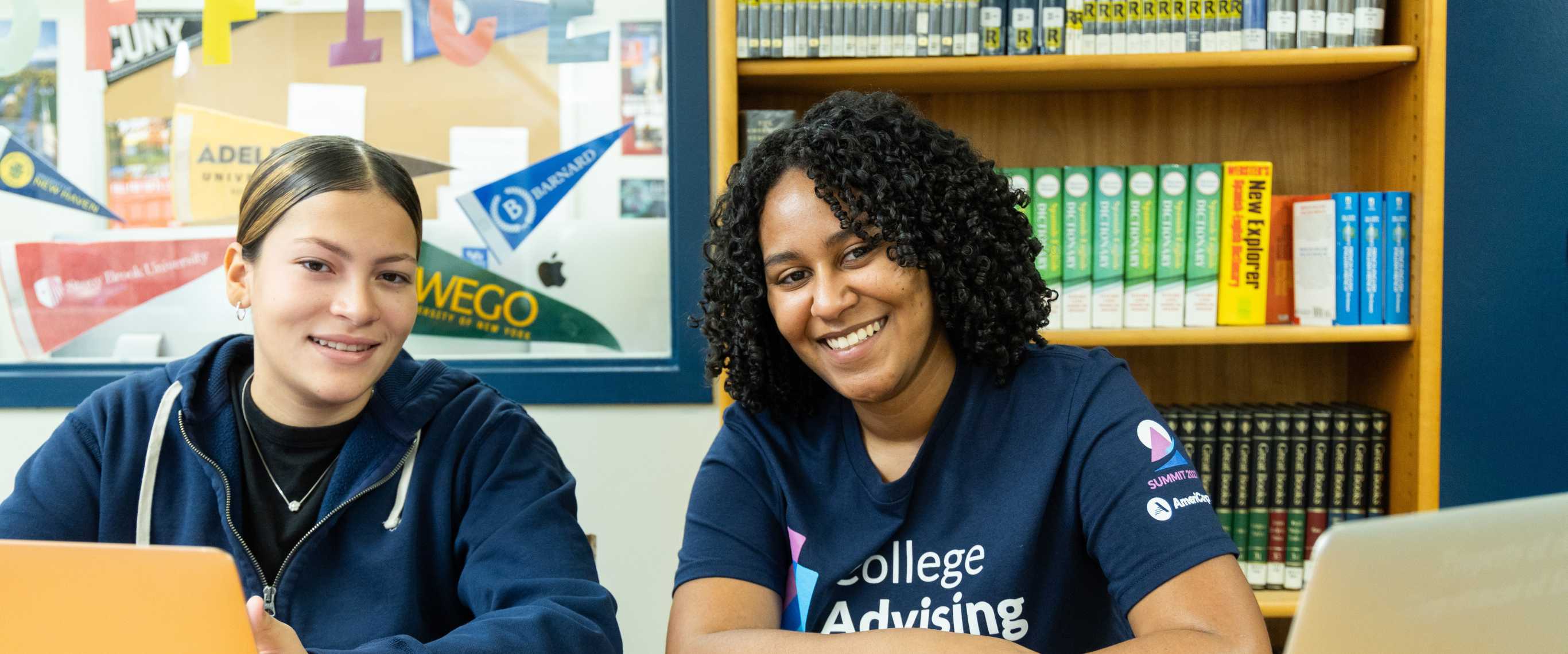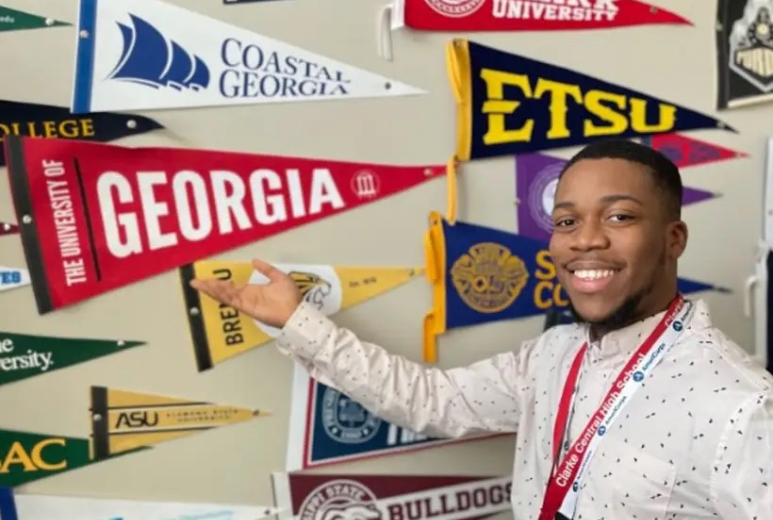She was the ideal college applicant. But this first-generation student needed more help.
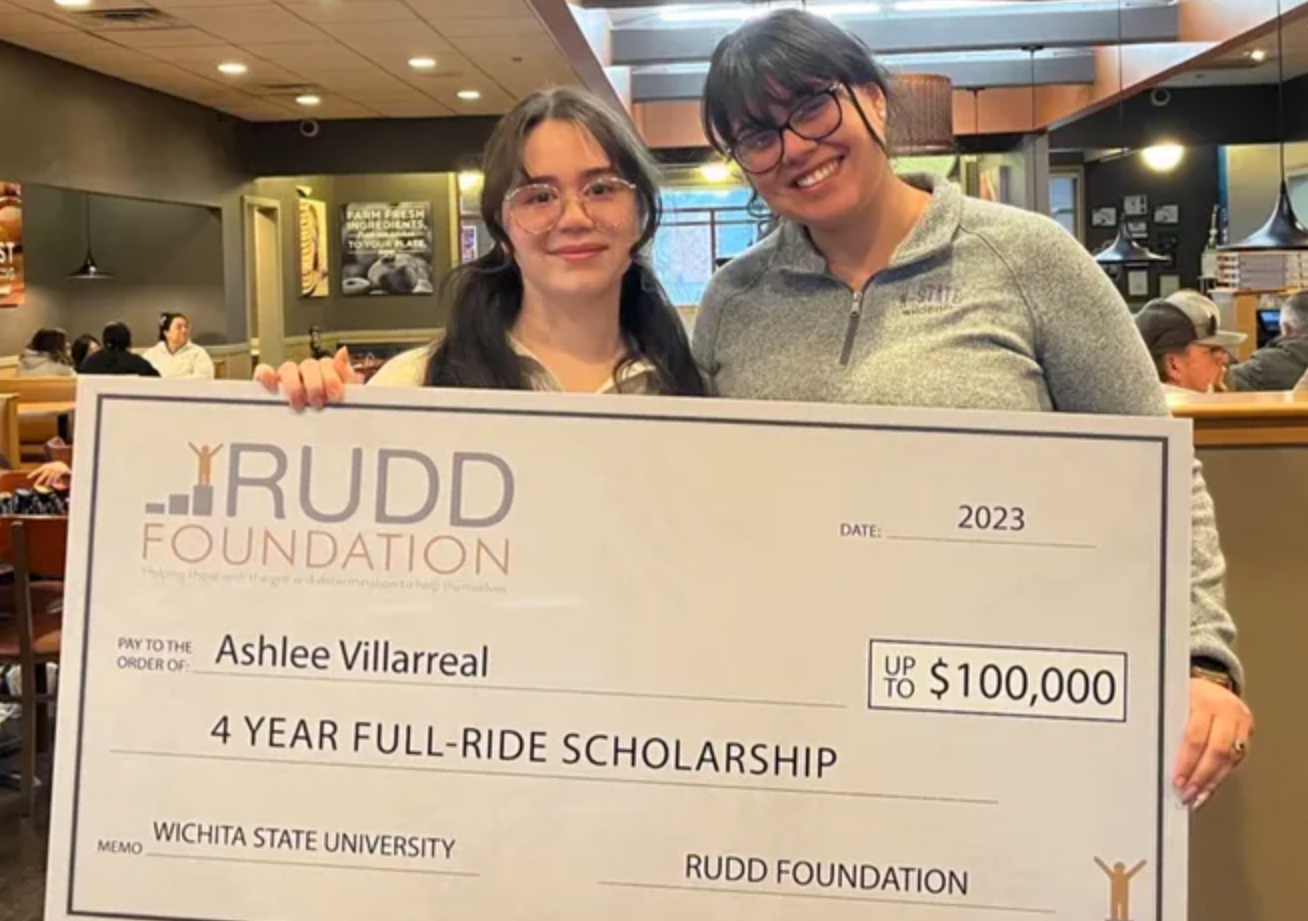
GARDEN CITY, Kansas – “Eat Beef, Keep Slim,” the feedlot sign shouts in this rural stretch of southwest Kansas.
Ashlee Villarreal’s parents – her Tejano father, her Mexican mother – came here when she was young, part of an influx of Latino families who helped Garden City grow from almost 23,000 people in 1990 to more than 28,000 just a decade later.
Like many, they had come here to work at the Tyson Foods meatpacking plant, where they hoped to give their children the chance at a better life.
It was tough work. The type you could build a good life on. The kids grew, and the bills, too. Then the pandemic hit. Her dad worked five days a week at the plant, and spent weekends taking on spot work as a car mechanic. His body was breaking down after years of physical work, but he kept going. There was no other option.
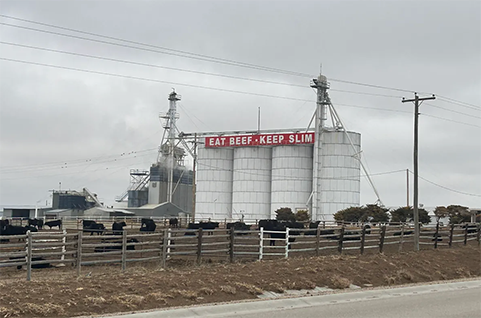
Nick Fouriezos/Open Campus
Stuck at home her freshman year of high school, Ashlee saw her father’s work ethic up close. It inspired her. But it also made her worry about the cost of going to college. Her family already had taken out loans to send her sister to Wichita State. And she couldn’t stand the idea of them borrowing more.
She wasn’t willing to watch her dad continue working 12 hour shifts to pay them off.
Student loan forgiveness: Some 7,400 students of shuttered for-profit college will have debt canceled
College dreams
While Ashlee wondered how to get to college one day, Evelyn Irigoyen-Aguirre was 140 miles away, graduating from Fort Hays State University.
She, like Ashlee, was born in Mexico and grew up in Garden City. Her dad worked the oil fields while her mom cleaned hotels in the morning and houses in the evenings. They arrived in 1998, just a few years before Ashlee’s parents. Migrating from Chihuahua, Mexico, carrying the same dreams and baggage, when Evelyn was just five months old.
Back then, she didn’t know why that would eventually matter. She didn’t know, when her first grade teacher had the class dress up as U.S. presidents, that she could never be one.
Still, that teacher fostered other dreams in Evelyn, always telling her that one day she would be a Kansas State Wildcat, like he was.
It wasn’t going to be an easy path.
She and her mother were deported the summer before fourth grade, and went to live with her abuela in Chihuahua. When she returned in the middle of fifth grade, after finally getting approved for U.S. citizenship, she felt even more pressure to pour herself into her studies.
She worked multiple jobs to pay for her associate degree from Garden City Community College and bachelor’s degree from Fort Hays State in 2020. She began a master’s degree in education administration, but returned home during the pandemic to be back with her family.
Looking for work in Garden City, she took a paid internship at the high school, and soon found herself pacing the same hallways she had walked as an upperclassman just a few years before.
The same ones Ashlee now walked, too.
Focus on first-generation students: After Supreme Court affirmative action ruling, new attention may come to this group of applicants
Nearly 408 students for every counselor
Ashlee was frustrated.
She was doing everything she could. But she needed more help, and the high school’s adviser only had enough time to focus on juniors and seniors closer to graduation.
“You’ve got time,” Ashlee remembers the adviser telling her, when she asked for a meeting.
But time was exactly what Ashlee felt like she didn’t have.
She was still just a teenager, but in Garden City, and other rural towns across America, she and her classmates often had to be so much more: drivers for their siblings, translators for their parents, breadwinners for their families.
With all those responsibilities, trying to also navigate the complex college process alone can be daunting. Yet there are nearly 408 students for every 1 counselor in America, a ratio significantly higher than what experts recommend, leaving many students juggling the admissions and scholarship process alone.
To craft the perfect college resume, Ashlee racked up more than 100 community-service hours and participated in two leadership organizations, the K-State College and Career Ambassadors and the Hispanic American Leadership Organization.
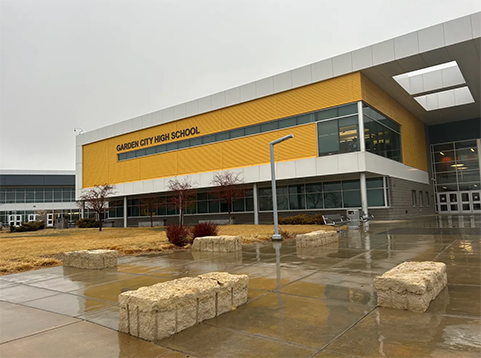
She played two sports, soccer and tennis, and stacked other extracurriculars, activities like math relay, scholars bowl, wind ensemble, and marching band.
Meanwhile, she was also working 20-35 hours a week at Hobby Lobby, stashing away whatever cash was left to pay school fees, the cost of extracurriculars, and other expenses she could take off her family’s plate.
Sometimes, when the nights went so long they turned into mornings, she would text her friend, Kaitlin Saldaña, herself working two jobs, also busy beyond belief.
“You still up?” Yup.
“You done with the essay?” Nope.
Everything changed for Ashlee when Evelyn arrived.
‘Near-peers’ to help first-generation students to college
They first met at the high school’s career center. Evelyn was an intern, and Ashlee was starting her junior year, looking for answers to the many college questions others hadn’t had the time for.
Evelyn was uniquely suited to help Ashlee and her Garden City classmates.
She knew what it was like to be “too Mexican to be American, and too American to be Mexican,” as many here say. She understood what it was like to have parents who constantly told her how important higher education was, but had no idea how to help get her there.
After her internship, Evelyn stayed on at the high school, securing a two-year contract as a college adviser there with the Kansas State Advising Corps.
The Advising Corps has mostly served Kansas City since it began in 2016, but state officials recently allocated funds to add the program’s advisers to more than 50 schools. Its strategy is built on research showing the positive impacts school counselors can have on improving college-going, and the way representation can particularly help improve education outcomes for students of color.
By hiring “near-peer” advisers, who have similar backgrounds and are close in age to the students they help, the Advising Corps hopes it can increase the number of first-generation, low-income students like Ashlee who go to college.
After getting hired by the Advising Corps, Evelyn was able to stay at the high school for Ashlee’s senior year. That meant a lot to Ashlee, who, before Evelyn, hadn’t known where to get help. Neither of her parents had gone to college. Her dad spoke little English, and her mom, next to none.
“It’s the FAFSA,” Ashlee told her parents, trying to find the right words for academic jargon she barely understood herself.
“OK, but what is that?”
Evelyn not only knew what the Free Application for Federal Student Aid was, but also what it was like to be a lifelong translator for her parents.
She knew how Ashlee could get waivers to take the ACT for free, and also how every dollar counts when you’re trying to get good grades while also working to support your family from a young age.
“Write everything down. Don’t forget,” Evelyn told Ashlee, when it seemed like it was all just too much to manage.
“If you ever need help, I’m here.”
The push to avoid student loans
Last August, Evelyn told Ashlee about the Rudd Scholarship, which covers the full four-year costs of college for a handful of low-income Kansans with “the grit and determination to achieve their long term goals.”
If Ashlee got the scholarship, she could go straight to Wichita State without taking a single loan.
She could attend university without putting any more weight on her dad’s shoulders.
Still, it seemed like an impossible dream. Not with my luck. I can barely win a scratch-off ticket, she thought to herself.
Evelyn encouraged her. She wrote a recommendation letter, and helped Ashlee through the application this past fall.
They included every part-time job. Every extra curricular. Every essay. Every hour of community service.
They sent in the application. And, then, they waited.
The final sprint
The next months were challenging.
Ashlee’s savings disappeared in a series of medical bills after suffering a sports injury that only got worse, since she never had time to slow down or recover.
The bills had just been paid when the Rudd Foundation finally contacted her in early January. They wanted to interview her for the scholarship. Could she make the three-hour drive to Wichita in the next few days?
Her family scrambled to put together the money for the trip. Her dad took time off to drive her, the Kansas plains passing by as the past three nights of interview prep played over in her head.
She was nervous, but felt the interviews went well.
Then there was more waiting, until February, when Evelyn called Ashlee’s mom.
“Are you on the speaker phone?” Ashlee heard Evelyn say. “Go off of it.”
Evelyn said that Ashlee had an interview for the “Kansas State College and Career Ambassadors” program the next day, and that she should wear something formal.
The next day turned out to be a snow day, so they moved the meeting to an IHOP. Ashlee and her mother arrived, and just as they sat down the waiter passed her a menu that read: “It’s a great day to be a Rudd Scholar.”
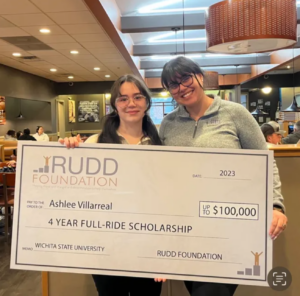
Ashlee and Evelyn. Photo: Courtesy of Evelyn Irigoyen-Aguirre
What Ashlee thought would be another interview was, in fact, a celebration. The foundation had made its decision: Ashlee was going to Wichita State on a full ride, joining the Class of 2027 this fall.
No more hurdles to jump through. Just her being handed a huge, lottery-style check – with Evelyn right there beside her.
This article was reposted from USA Today and originally published in Open Campus.
